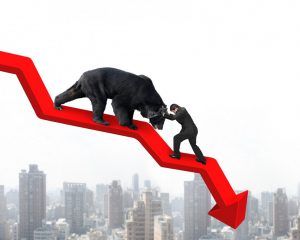Tag: best penny stocks
How To Avoid Style Drifting When Trading Today’s Stock Market
The more successful and experienced you become as a trader, the more in touch you are with your strengths and weaknesses. Just like a pitcher in the MLB, they are aware of what types of pitches they throw that give the opposition difficulty. On the other hand, a good trader can tell you what their bread and butter trades are in today’s stock market.
However, from time to time, you’ll hear about other traders making large sums of  money doing something that you’re not exactly well versed at. So, instead of trying to learn what exactly they see, you blindly jump in with profits on your mind.
money doing something that you’re not exactly well versed at. So, instead of trying to learn what exactly they see, you blindly jump in with profits on your mind.
Generally, when you can’t explain why you’re in a trade, along with the exit points, you’re already on shaky grounds. However, it’s human nature to get caught up into something, but it should still be our main focus.
The worst is when you take on a trade that is out of your wheelhouse, and it ends up eating away at entire day’s profits. This type of behavior is often referred to as style drifting. Style drifting is one of the worst habits to have as a trader in today’s stock market.
How can you avoid style drifting in trading?
Well, an easy way is to consistently reinforce yourself what your bread and butter trades are. By categorizing your trades, you’ll be able to figure which ones are the best based on P&L. On other hand, you’ll find out which types of trades don’t suit you well. Getting familiar with your own trades will help you focus on what needs to be done in order to be successful in today’s stock market.
 Now, there is nothing wrong with trying new trading strategies. However, these trades should be sized so small that it doesn’t affect your overall P&L. If you’re trading was conducted like a business, then these new trades are trying to show proof of concept. Once they show enough promise, you then can increase your share size and scale up.
Now, there is nothing wrong with trying new trading strategies. However, these trades should be sized so small that it doesn’t affect your overall P&L. If you’re trading was conducted like a business, then these new trades are trying to show proof of concept. Once they show enough promise, you then can increase your share size and scale up.
With that said, keeping a trading journal is extremely important. There is no way you’ll be able to remember every single trade in your head. Eventually your brain gets foggy, and you tend have selective memory when it comes to your trading. However, a detailed journal will allow you to refresh your memory and walk through the entire process over again for today’s stock market.
Not only that, but it will keep you accountable for your actions. For example, some traders might plead ignorance as their defense for putting on a bad trade. But if they  only studied their performance, they would know exactly how they fared on specific types of plays.
only studied their performance, they would know exactly how they fared on specific types of plays.
As noted earlier, you should always work on your skills and new ideas. But always focus on your bread and butter trades, and see how they can be better. If you’re unsure of what they are, it could lead to style drifting, trading aimlessly without a plan. A great way to avoid style drifting is to review and journal your trades. Style drifting happens to everyone, but the better traders make it less and less of a habit in today’s stock market.
How News Helps With Trading Hot Penny Stocks
We live in a world where algorithmic trading dominate the daily volume seen in the stock market today. With that said, there are a ton of news reading algos that react to headlines instantaneously, causing tremendous volatility in the company’s referenced in the stories, especially hot penny stocks.

Some traders who rely on technical indicators to make decisions will totally dismiss news all together. Their belief is that the news is already priced into the stock and the price action will dictate where it will go. They feel it’s extremely difficult to quantify the impact of the news so it’s more or less a waste of time to follow it.
Does this philosophy make sense, and how important should following the news be when trading hot penny stocks?
Let’s say the stock price of company ABC has had support at $15, if it were to drop to that level, a trader relying solely on technical analysis will buy some shares. The  stock price drops from $17 down to $15, the trader goes long, and the stock quickly drops another $3. It turns out that a news story broke out that ABC is under investigation for accounting fraud and that the CEO has left the country.
stock price drops from $17 down to $15, the trader goes long, and the stock quickly drops another $3. It turns out that a news story broke out that ABC is under investigation for accounting fraud and that the CEO has left the country.
Here is a situation where there is a dynamic change in the company’s fundamentals. If you’re an investor, you’re thinking worst case scenario, you’re not necessarily thinking about support and resistance levels. You’re mind is thinking, get out, and ask questions later.
Clearly, in a situation like this, knowing the news can be very helpful when trading hot penny stocks.
Let’s say you trade style utilizes a mean reversion strategy, and company ABC is down $6 and on average it trades in a range of $2. Again, not knowing the news, you might decide to buy some shares. However, if you paid attention to the news, you would have known they just announced their earnings and that additional volatility is not unusual.
This is another example where the news helps in making better trading decisions.
Now, you don’t have to try to quantify everything to make knowing the news useful. For example, let’s say a well known analyst upgrades company ABC and their stock price gaps up on the open. What is the upgrade worth? It’s really hard to say, clearly a positive sign, but hard to measure the impact.
Does that mean having that information is useless? Absolutely not – especially with penny stocks.
It’s when you try to overanalyze the news, in this case, it can causes problems in  your trading. For example, let’s say Company ABC has announced that are expanding their business to more regions, this might be seen as a positive news. However, it might not be reflected in their stock price right away.
your trading. For example, let’s say Company ABC has announced that are expanding their business to more regions, this might be seen as a positive news. However, it might not be reflected in their stock price right away.
Letting your opinion get in the way can also be an issue. For example, this is good news, the stock price should be going up…or this is really bad news, the hot penny stock price should be crashing.
With that said, it’s still better to be aware of the headlines and what is going on in the stock you’re trading. Sure, it’s very difficult to trade off the news, and not what is being suggested here. But including the news in your decision making process is a choice many traders make and they fare better when trading hot penny stocks.
Dealing With Drawdowns When Trading Good Penny Stocks
Make no mistake about it, if you trade good penny stocks for a long enough period, expect to experience drawdowns. We all go through periods when things simply don’t go away. However, there is a difference between going through a trading slump and having losing trades.
With that said, let’s take a look at both, and how they affect our trading.
Now, depending on your strategy the number of drawdowns will vary. For example, if someone primarily only trades M&A deals, they might make money 95 out 100  trades. However, those five times that they are wrong can be costly. On the other hand, a discretionary trader might be right 40-60% of the time, and still manage to be very successful.
trades. However, those five times that they are wrong can be costly. On the other hand, a discretionary trader might be right 40-60% of the time, and still manage to be very successful.
A drawdown is simply a trade that is closed out for a realized loss. On a more macro level drawdowns can also be expressed in time periods. For example, one could say they drew down on the day, week, or month if they ended up realizing losses.
As mentioned, drawdowns are a part of the game. It’s important to understand that trading good penny stocks, in many ways, is a probability game…there are very few, if any certainties. The sooner you accept that, the better you’ll be.
You can learn just as much from your losing trades as you can from your winning trades. If you’re going through a losing period, take a step back and start scrutinizing your previous trades.
Ask yourself, “Are these mistakes are avoidable, or am I just a victim of variance?” Sometimes, we let our emotions interfere with our game plan, which ends up being a costly mistake. Of course, it can be more than that.
 For example, maybe there has been some shift in the market, and your strategy or thesis is no longer valid. Maybe a CEO resigns, or a new government law is comes into effect. A number of factors could come into play that would affect the dynamics of a company and its stock price.
For example, maybe there has been some shift in the market, and your strategy or thesis is no longer valid. Maybe a CEO resigns, or a new government law is comes into effect. A number of factors could come into play that would affect the dynamics of a company and its stock price.
Is the root of the problem in your mechanics? Analyze your execution and see if there is anything is different. Have you not adjusted your position sizing for the added volatility? Go through your process and see if there is anything different and worth noting.
Maybe you’re going through some personal changes. Ask yourself if you’re getting enough sleep, eating well, or dealing with stressful relationships. These are things we don’t think about that could affect our trading of good penny stocks, but they can…therefore, they’re worth addressing and trying to correct any of these problems.
For some, a series of losses could lead to confidence issues. It’s generally best to focus on improving your process. For example, instead of trading your normal tier size, scale down the number of shares down and just focus on executing your game plan.
Do this until your confidence comes back. What you don’t want to do is trade bigger in order to regain losses. You want to be trading your biggest when you’re most confident in your ideas, not when you’re having doubts and are unsure. That’s the secret to making the most of good penny stocks.
Top Penny Stocks Only Work If Traders Journal Their Trades
Now, there are just over 250 trading days in the year. Let’s say you’re an active trader and traded on average 3 top penny stocks per day. That adds up to 750 individual trades. Unless you have a photographic memory, you’ll probably only remember a handful of these trades, maybe your big winners or losers, or some interesting story that is tied into the trade. However, there is no way you’re going to remember all of them.
The time you spend in front of your screens can either be valuable or a waste, it’s really up to you. A valuable way to spend your time is by reviewing. It’s more or less  the same thing professional sports teams do when they study video footage of their opponents or previous game(s). They are examining to see if there is anything useful that they can find for their next encounter with the top penny stocks.
the same thing professional sports teams do when they study video footage of their opponents or previous game(s). They are examining to see if there is anything useful that they can find for their next encounter with the top penny stocks.
You can do the same thing by keeping a journal. Now, you don’t have to actually sit down and write in a notebook, if writing on your computer is easier, that works as well. The key is start recording information about your trades, thought process and tendencies.
If you’re unsure about what to journal here is some help:
Trade information: the time when the trades were made, whether you bought or sold, number of shares, holding period, and profit/loss.
Trade Thesis: In this section you would write about why you got into the trade and explain your edge in the trade.
For example, let’s say the stock price of a company was up 10% on a rumor that it might seek to put the company for sale. However, an hour later a company spokesperson comes out and denies the rumor. Some traders might start shorting  the stock off that headline. Their thesis is that the stock price rose on a belief that turned out to be false and because of that the stock should sell off.
the stock off that headline. Their thesis is that the stock price rose on a belief that turned out to be false and because of that the stock should sell off.
Well Being: In this part you want to write down about how you felt going into the trading day. For example, did you feel tired/refreshed, were you distracted/focused, did you start your day early/late/on time. Those are just some things worth considering. Some traders trade very poorly if they are hungover, while others don’t trade well without their coffee and breakfast. Find out what works for you and what doesn’t, and focus on winning with the top penny stocks.
Execution: Before every trade you should have your risk/reward mapped out. For example, I’m going to get in at this price and out here if i am wrong.
Once you know what your execution strategy is, then compare it to how you actually traded your plan. For example, let’s say you wanted to exit your long if the stock price dropped to $10, but for whatever reason you got out at $10.05.
Why?
It’s worth trying to answer why you were able or unable to follow through on the trading plan.
There is a lot more that you can include in your journal, these were just some ideas for you. The most important thing to do is journal, study and strive to improve trading the top penny stocks.
Should Day Traders Who Buy Penny Stocks Fear The Tick Size Experiment?
On October 3, 2016 the tick size pilot program was introduced into the market. It’s the regulators attempt to add liquidity to small cap stocks. The program consists of a control group and three test groups, there are 400 stocks per test group. Should day traders who buy penny stocks worry?
 The control group trades regular. On the other hand, the first test group will be quoted in five cent increments. For example, instead of seeing a stock being quoted 5.01 by 5.02, you’ll see it quoted in five cent increments like 5.00 by 5.05.
The control group trades regular. On the other hand, the first test group will be quoted in five cent increments. For example, instead of seeing a stock being quoted 5.01 by 5.02, you’ll see it quoted in five cent increments like 5.00 by 5.05.
Now, the second group is also quoted in the same fashion as the first group. However, there are some exemptions. Moving on, the third group works in the same way as the second, but they have exemptions for big block trades. Not only that, but they are subject to the trade-at-rule, which means you have to trade what is displayed on the exchanges before trading and buy penny stocks on a dark pool.
So the idea by having stocks trade in five cent increments is that market makers will be incentivized to facilitate orders. However, there are fewer and fewer traditional market makers left. The majority of market making is done by HFT and prop firms. For example, we wouldn’t have as many flash crashes in individual stocks if we still had traditional market makers.
You want to hear something crazy?
The person who helped lead the charge for the tick size pilot program is a former reality tv star turned politician. That’s right, not someone with a finance background or an understanding of market structure. You might not remember this, but the stock market used to trade in fractions, we later moved on to our present market structure where stocks are quoted in penny increments. So this change is kind of like going backwards if you think about it as someone that may potentially buy penny stocks.
Another argument on why the tick size program makes sense is that it might lead to  more coverage by banks. The idea is if banks get involved with market making, then their research departments will also start covering the stock. Better research on the stocks should lead to greater interest from investors. In their perfect world that’s how the dominos will fall.
more coverage by banks. The idea is if banks get involved with market making, then their research departments will also start covering the stock. Better research on the stocks should lead to greater interest from investors. In their perfect world that’s how the dominos will fall.
Every trader looks at the bid-ask spreads and makes a decision on whether the stock is worth trading. For example, if the average volume is low, the bid-ask spread is wide, and the depth of book is thin, then a lot of traders will avoid trading a stock like that. Generally, penny wide spreads, high volume, and a ton of bids and offers stacked on the book, are what most traders that buy penny stocks are looking for.
Overall, this sounds like an awful idea. The goal of the program is to collect data and see if situations improve in these low cap names. With that said, the program is running for about 2 years, so it’s not permanent. We’ll see how it plays out, whether or not the theory works in the real market for traders that buy penny stocks.
